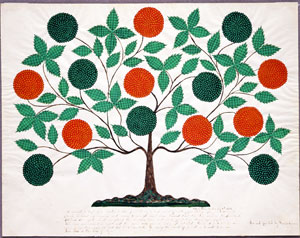1.17.25 — Shaking Loose
There is not a lot of shaking going on at the American Folk Art Museum, unless it is deep inside one’s soul. In fact it can be hard for an outsider to imagine the shaking and quaking that animated prayer meetings of the Shakers and Quakers, giving them their name.
 One remembers instead the clarity and simplicity of Shaker furniture. One remembers, too, the removal from modern life in the Quakers, a lifestyle that most today would find confining. Yet a show makes the case for the Shaker esthetic as “Anything but Simple,” through January 26.
One remembers instead the clarity and simplicity of Shaker furniture. One remembers, too, the removal from modern life in the Quakers, a lifestyle that most today would find confining. Yet a show makes the case for the Shaker esthetic as “Anything but Simple,” through January 26.
There had to have been more than the obvious to that esthetic, for the Shakers lived with it and let it shape their lives. Photos at the museum show objects in their place in homes from which people have long vanished, and one can feel the furniture and people alike close at hand. They did not need to go far in pursuit of a revelation. At the same time, they embraced simplicity as one of the prime virtues along with celibacy, pacifism, and egalitarianism. The combination of esthetic, practical, and spiritual virtues has long become an emblem of an older New England for the Shakers and rural Pennsylvania for the Quakers. It seems as essentially American as Washington crossing the Delaware.
Nor is it entirely passed. Shaker craft opens the exhibition along with the photographs, with all its richness in simplicity, like the wood grain and dark stain of nested oval boxes. Everything fits. Much the same paradox animated Minimalism in the 1960s, for all its industrial esthetic. Donald Judd, Carl Andre, and Agnes Martin wanted to keep their hands dirty and their vision clear. That decade also looked to Quaker pacifism in response to the Vietnam War.
Like a viewer today, the Shakers lived in more than one time at once. They began shaking loose in England before taking their millenarian project to the United States in 1774, where they revered a founding figure in Mother Ann, or Ann Lee. There had to be something more, they felt, than the Enlightenment march of time or the hairsplitting of organized religions—and they found it in a perceived act of restoration. Much the same thoughts motivated Hassidic Jews in Eastern Europe in those same years. Like the Quakers, they, too, dress for those years while claiming the very first millenium. The Shakers just happened to turn out art and merchandise worth something today.
They knew it, too, and they meant their “gift drawings” of the mid-1800s for a larger public, for sale as a means of financial support. Yet their images of wreaths, hearts, fruit, and the tree of life also encode the gifts of heaven. They really did know beauty as soul shaking. They can close in on a single leaf or multiply their fruit, in bright, flat colors distinct from both “outsider art” and the brilliant illusion of Baroque still life and Romantic images of nature. Text at times helps to explain the code, barely breaking the symmetry, but you may not need it. Call it the calm after the quaking and shaking.
If the 1960s found something to admire, it may have rendered their austerity all but superfluous. Not that a movement devoted to celibacy had long to live. The movies and metaphors aside, there was no apocalypse now. Their dying off may explain so small a show—alongside selections from AFAM curated with an eye to Thornton Dial, the artist, and a packed display of game boards. It could serve as a preamble to the Met’s rehanging of its American wing on its hundredth anniversary, but also a rejoinder. Something here still brings stillness and bears fruit.